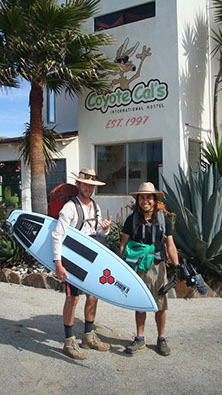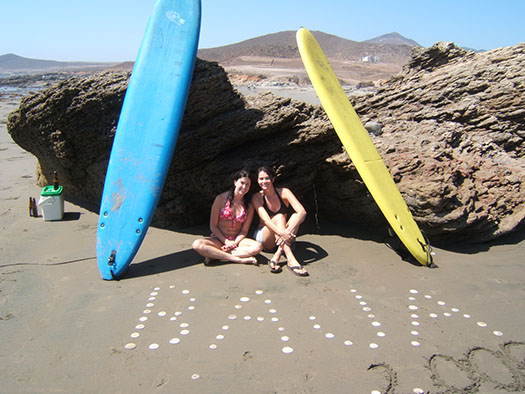Surfing K-181, Punta Cabras and the Punta San Isidro area near Coyote Cal’s hostel, is one of Baja’s best kept surfing secrets. Safe, un-crowded and mainly deserted beaches with reef-breaks, sandy coves and long sandy breaks offer excellent year around surfing in all conditions, including northwest and south swell. The jam’n breaks of Long Beach, the big wave break of River Mouth and its 100 meter long board ride, make the area in many ways better than Quatro Casas, Shipwrecks and Freighters.
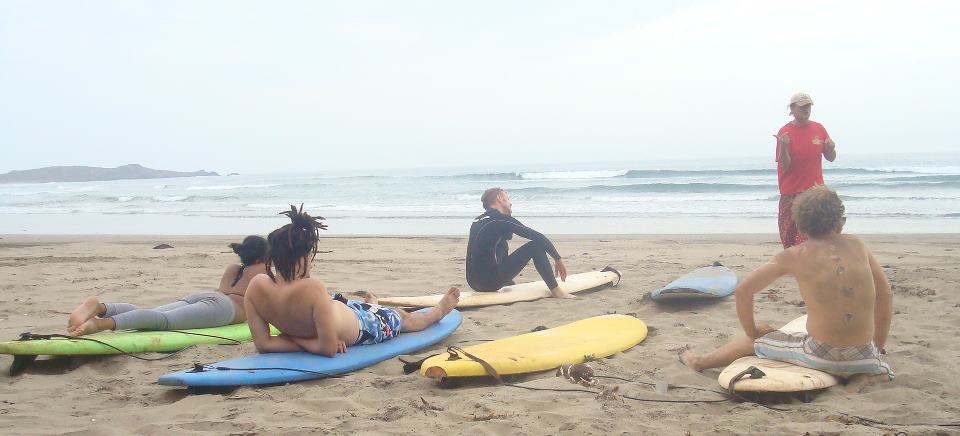
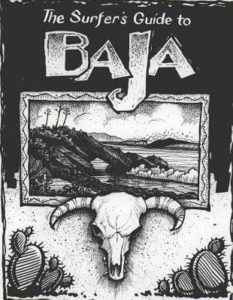 We recommend every person surfing Baja to purchase a copy of “The Surfer’s Guide to Baja”. What our good friend Mike Parise says is “right on” and timeless. Our goal, on this web page, is to add to his already good advice on surfing the Erendira and Punta Cabras breaks. (Regarding his directions on how to get to Erendira surf breaks, please note that the term K-181 refers to a time when the kilometer markers started their count at the US border.) You will now notice the kilometer markers reset the count at Ensenada and again at the Bay of Los Angles. The K-181 turn-off is now K-78.) (See link page to buy one!)
We recommend every person surfing Baja to purchase a copy of “The Surfer’s Guide to Baja”. What our good friend Mike Parise says is “right on” and timeless. Our goal, on this web page, is to add to his already good advice on surfing the Erendira and Punta Cabras breaks. (Regarding his directions on how to get to Erendira surf breaks, please note that the term K-181 refers to a time when the kilometer markers started their count at the US border.) You will now notice the kilometer markers reset the count at Ensenada and again at the Bay of Los Angles. The K-181 turn-off is now K-78.) (See link page to buy one!)
Since our start over twenty years ago, we have taken good care of the surf riders of the area. Our safe camp grounds have hot showers with an enclosed private dressing room, a restroom and a dining area. We also have racks for your boards, wet suit dip tanks and a special wet suit drying area. We also offer rental of Body Glove wet suits in both men and women’s sizes, and soft-top surf boards. Our clean hostel accommodations include breakfast, internet use and a kitchen facility. The Bare-Foot bar is a surfer’s paradise with 80 different tequilas, beer, game-room and weekend camp fires. Happy hour starts at 5pm!
The waters in the Erendira/Punta Cabras are very cold all year long. For your safety we suggest 4/3 full wetsuits at all times. We offer the best in surf equipment rental to insure your safe and comfortable surfing experience.
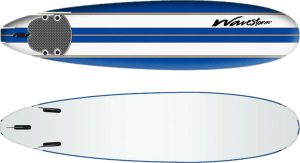
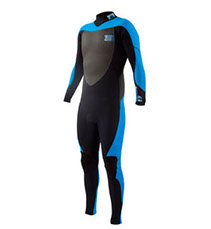
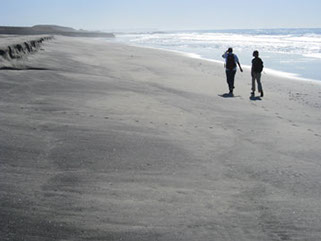 Surfing K 181 is a rocky reef and cobblestone area with both right and left breaks. In the center of the beach there is a large, shallow, flat rock shelf that creates excellent and consistent shape, especially during low tide and small swell.
Surfing K 181 is a rocky reef and cobblestone area with both right and left breaks. In the center of the beach there is a large, shallow, flat rock shelf that creates excellent and consistent shape, especially during low tide and small swell.
During larger swell, the waves break outside this shelf area, but reform to make 100 meter plus rides. (During years of heavy rain, this shelf may be covered with sand and effect the consistency of the breaks.) The waves are often glassy due to kelp beds. During winter’s northwest swell, the waves can get to nine (9) to twenty-five (25) feet. During these times, a reef break forms 100 meters from shore. The deep water surrounding the reef makes it easy to ride the break and then swim around for another ride!
The north end of the beach has cobblestone beaches and has a good right point break.
Be careful of sea urchins and a strong under tow near the shore line. The Boca de Rio break is tide sensitive so the surf comes up and down during the course of the day. There is high thief is this area, so it is best to store valuables at Coyote Cals before your surf session. River Mouth is virtually unknown to surfers! Boca de Rio is about three miles south of Coyote Cals.
Located in the harbor of Castro’s fishing camp, to the left of the boat ramp, there is a small narrow area of the beach that can catch a swell that passes through the reef opening of the harbor entrance. The break is super glassy because of the kelp in the harbor. Not often, but at times, an ultra clean long board right brake happens. It’s always a good idea to take a look as you pass the end of the cliffs as you approach Castro’s fishing camp. Nobody knows about this break! It’s about one mile south of Coyote Cals.
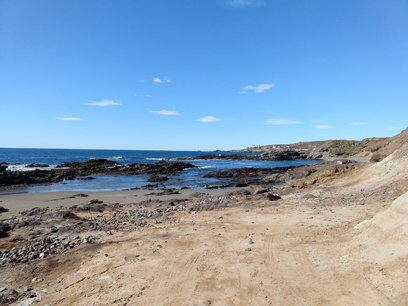 A few sandy coves flanked by volcanic reef and shoreline are located between Coyote Cals and the housing area of Punta Cabras. The best known of these coves is walking distance north from Coyote Cals and we call the break “Barney’s”. The break is glassy even when there is wind. It has a shallow sandy bottom that extends more than 100 meters.
A few sandy coves flanked by volcanic reef and shoreline are located between Coyote Cals and the housing area of Punta Cabras. The best known of these coves is walking distance north from Coyote Cals and we call the break “Barney’s”. The break is glassy even when there is wind. It has a shallow sandy bottom that extends more than 100 meters.
This makes it a very good break for low to medium swell. The surfing area is narrow because of sharp, shallow volcanic reef and rocks. It requires constant swimming to stay in the surfing channel. A friendly Mexican swatter has now illegally fenced off this area but you can enter from the north side. The beach is public domain! This is usually a long board break and is virtually unknown to surfers!
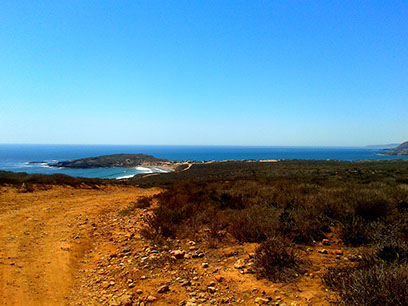 Half Moon Bay surf break is located north and behind the houses of Punta Cabras. At the top of the hill you journey left toward the ocean and down into the bay. At the beginning of a large sand dune area, starts a ramp that allows you to walk down to the break. (Do not drive in the soft sand of the dunes. The friendly Mexican that lives there makes good money towing out the unwise.)
Half Moon Bay surf break is located north and behind the houses of Punta Cabras. At the top of the hill you journey left toward the ocean and down into the bay. At the beginning of a large sand dune area, starts a ramp that allows you to walk down to the break. (Do not drive in the soft sand of the dunes. The friendly Mexican that lives there makes good money towing out the unwise.)
The best surfing is not the large beach located at the foot of the ramp but a small hidden cove located around the small southern point to the left. (99 percent of those who surf Half Moon Bay don’t know that.) What makes this break so unique is that it’s turned around almost 180 degrees. Therefore, an onshore wind is an off-shore wind for Half Moon Bay!
The large point break also cleans up heavy surf but also reduces the size of the waves. So if surf is garbage at other breaks, it can be clean at Half Moon Bay. Half Moon Bay is three and a half miles north of Coyote Cals.
Just north of Half Moon Bay and on the north side of the sandy point is Sunset Beach. It is the far south end of a sandy two mile long beach we call Long Beach. You must park near Half Moon Bay and walk over the sandy point to get there. Sunset is a left point break with a strong year around rip current that gives you a free ride to the break’s peak. It is a good all around break with larger surf than other breaks in the area. It is completely hidden and is virtually unknown to surfers! Careful, the south side of the break is a rocky sharp volcanic shore. Sunset is about three and a half miles north of Coyote Cals.
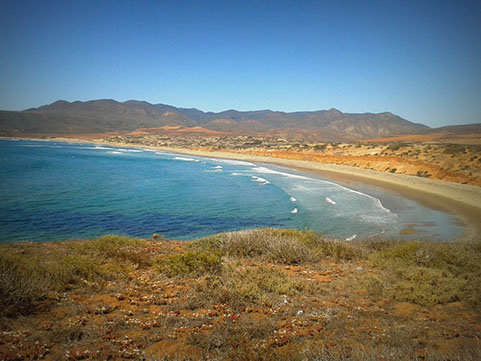 When surfers talk about surfing Punta Cabras they are probably talking about the area’s most well known break, “North Long Beach”. With two miles of sandy beach breaks and at its northern end, an excellent right point break with a strong rip current that takes you to the break’s peak without swimming. It is the surfer’s choice. Or as “The Surfer’s Guide to Baja” states: it’s “just plain good waves.” Located at the north end of the sand dunes, it is between Bate’s Ranch and Tampico.
When surfers talk about surfing Punta Cabras they are probably talking about the area’s most well known break, “North Long Beach”. With two miles of sandy beach breaks and at its northern end, an excellent right point break with a strong rip current that takes you to the break’s peak without swimming. It is the surfer’s choice. Or as “The Surfer’s Guide to Baja” states: it’s “just plain good waves.” Located at the north end of the sand dunes, it is between Bate’s Ranch and Tampico.
The road opens up to a large flat area resting on top of a small cliff overlooking the break. This place can gets crowed on the holidays and weekends, but is all yours in the middle of the week. If your vehicle can drive on the sand, you can enter the beach at the end of the sand dunes and park in front of the break. The waves are larger here than at other breaks. All year long the quality of the waves are excellent. Sand bars and an irregular bottom can cause back wash and holes that can kill your ride.
The north side of the beach is a rocky volcanic shore with dangerous currents and channels. You must always be alert to stay centered in the rip and time you exit to stay safe! The rip is known to drop you off in the impact zone so you will have to swim a bit further to wait for your ride. North Long Beach is five miles from Coyote Cals.
The next break north of North Long Beach is La Calavera. This is a sandy cove with an excellent sandy beach break. It is glassy and protected by the nearby cliffs from wind. Almost no one surfs here because the area is fenced by the friendly Mexican who lives there. However, he welcomes all, and never says no to a surfer who what’s to open the gate to get to the waves. When Long Beach is a zoo, this place can be all yours! About six miles north from Coyote Cals.
Baja Experience Tours is a leader in group surfing lessons and is a great way to learn how to surf at Coyote Cal’s with your friends and family. Clic on his link for surfcamp schedules in Baja California at Coyote Cal’s!
